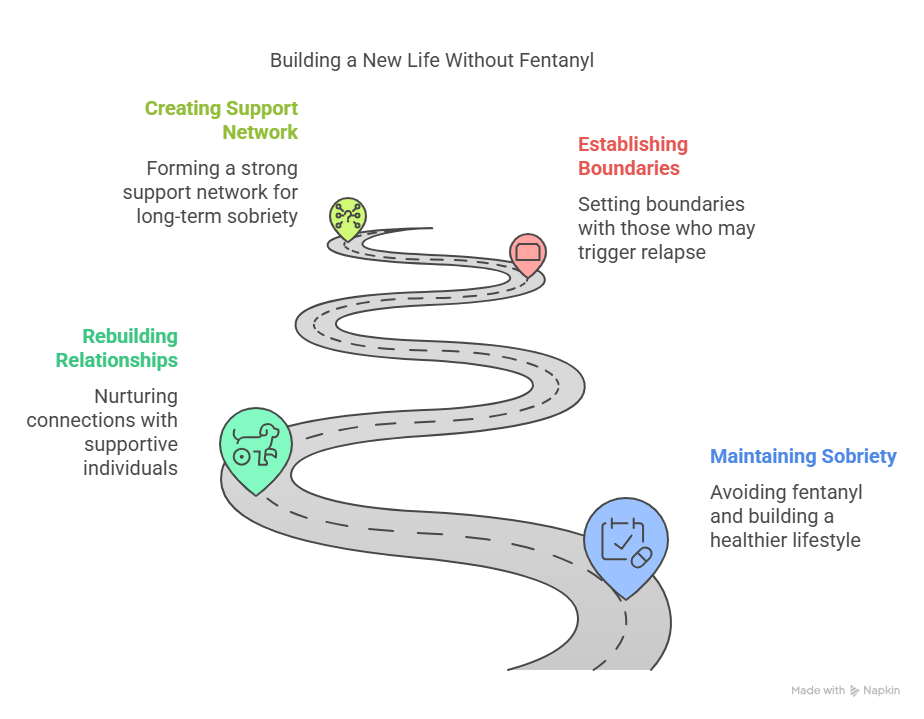Overcoming fentanyl addiction is a challenging journey, but it’s achievable when taken one day at a time. For many, the path to recovery seems daunting, but with the right mindset and support, individuals can break free from the grip of this powerful opioid.
Recovery is a process that requires patience, resilience, and a commitment to change. By focusing on the present moment and taking it one day at a time, individuals can begin to heal and rebuild their lives. This approach helps to make the journey less overwhelming, allowing individuals to celebrate small victories along the way.
Key Takeaways
- Recovery from fentanyl addiction is possible with the right mindset.
- Taking it one day at a time makes the recovery process less overwhelming.
- A supportive environment is crucial for a successful recovery.
- Celebrating small victories helps to motivate individuals throughout their journey.
- Patience and resilience are key qualities for overcoming fentanyl addiction.
Understanding Fentanyl Addiction
Fentanyl addiction is a serious condition that affects both the physical and psychological well-being of an individual. It’s crucial to comprehend the complexities of this addiction to devise effective recovery plans.
The addictive nature of fentanyl is attributed to its potency and the rapid tolerance it builds in users. This makes overcoming fentanyl addiction particularly challenging.
The Powerful Grip of Fentanyl
Fentanyl’s grip on individuals is devastating, causing significant changes in brain chemistry. This leads to intense physical dependence and psychological reliance.
Why “One Day at a Time” Is Essential
Adopting a “one day at a time” approach is vital in managing fentanyl withdrawal symptoms. This strategy helps individuals focus on the present, making the recovery process more manageable.
| Aspect of Addiction | Description | Recovery Approach |
|---|---|---|
| Physical Dependence | Fentanyl causes significant physical changes, leading to withdrawal symptoms upon cessation. | Medical detoxification and support |
| Psychological Reliance | The drug alters brain chemistry, creating a strong psychological dependence. | Counseling and therapy |
| Cravings and Triggers | Individuals often experience cravings and encounter triggers that can lead to relapse. | Coping strategies and support groups |
The First Steps in Your Recovery Journey
The path to overcoming fentanyl addiction begins with a single, crucial step: seeking help. This initial step is often the most challenging, but it’s a significant milestone towards recovery.
Understanding the importance of professional help is vital in the early stages of recovery. Professional Detox and Medical Support are critical in managing the fentanyl detox process safely and effectively.
Professional Detox and Medical Support
Medical detoxification is the first step in the recovery process, involving a team of healthcare professionals who monitor and manage withdrawal symptoms. This support is crucial for a safe and successful detox.
Navigating Withdrawal Symptoms
Withdrawal from fentanyl can be intense and uncomfortable. Symptoms can range from anxiety and agitation to severe physical pain. Medical supervision is essential to navigate these challenges.
Building Your Support System
A strong support system is vital for sustained recovery. This includes family, friends, support groups, and healthcare providers. They provide encouragement, guidance, and a network to rely on during challenging times.
| Support System | Role in Recovery | Benefits |
|---|---|---|
| Family and Friends | Emotional Support | Provides a sense of belonging and motivation |
| Support Groups | Community and Shared Experience | Offers a platform to share experiences and learn from others |
| Healthcare Providers | Medical and Therapeutic Support | Ensures professional guidance and care throughout the recovery process |
Daily Practices for Staying Clean From Fentanyl
Embracing a daily regimen is crucial for individuals recovering from fentanyl addiction. Establishing a routine can help manage cravings and reduce the risk of relapse. By incorporating healthy habits into daily life, individuals can strengthen their sobriety and improve their overall well-being.
Morning Routines to Strengthen Sobriety
Starting the day on a positive note can set the tone for sobriety. A morning routine that includes meditation, journaling, or a brisk walk can help individuals stay focused on their recovery goals. As noted by a recovery expert, “The way you start your day is crucial in setting the tone for the rest of the day.” Incorporating a healthy morning routine can be a powerful fentanyl recovery tip.
Midday Strategies to Maintain Focus
As the day progresses, it’s essential to maintain focus on recovery. Taking short breaks to practice deep breathing exercises or engaging in a hobby can help manage stress and cravings. Staying connected with supportive peers or mentors through regular check-ins can also provide an added layer of support.
Evening Rituals to Prevent Nighttime Relapse
Evening routines can play a significant role in preventing relapse. Engaging in relaxing activities such as reading or yoga can help calm the mind and body before bed. Avoiding triggers and creating a sleep-conducive environment are also crucial strategies for maintaining sobriety during the night. As one recovery slogan goes, “Relapse is not a failure, it’s a setback.” Having a plan in place can make all the difference.
Managing Cravings and Triggers
Managing cravings and triggers is a crucial aspect of avoiding fentanyl relapse. Cravings and triggers can be intense and unpredictable, making it essential to have effective strategies in place to manage them.
Cravings are the physical or emotional needs that drive an individual to seek out fentanyl, while triggers are the people, places, or things that can cause these cravings. Understanding the difference between cravings and triggers is vital in developing effective coping mechanisms.
Physical Techniques for Immediate Relief
Physical techniques can provide immediate relief from cravings. Some effective methods include:
- Deep breathing exercises to calm the body and mind
- Physical activity, such as a short walk or yoga, to distract from cravings
- Progressive muscle relaxation to release physical tension
Mental Strategies for Craving Control
Mental strategies are also crucial in controlling cravings. Some effective techniques include:
- Cognitive-behavioral therapy (CBT) to change negative thought patterns
- Mindfulness meditation to increase self-awareness and self-regulation
- Journaling to process emotions and identify triggers
Creating an Emergency Response Plan
Having an emergency response plan in place can help individuals respond quickly and effectively to cravings and triggers. This plan should include:
- Contact information for support groups and emergency services
- A list of healthy coping mechanisms and activities
- A safe and supportive environment to retreat to when needed
Treatment Options for Long-Term Recovery
Achieving long-term recovery from fentanyl addiction involves a combination of medical, therapeutic, and social support strategies. A comprehensive treatment plan is crucial for sustained sobriety, and there are several approaches that can be tailored to individual needs.
Medication-Assisted Treatment
Medication-assisted treatment (MAT) is a critical component of fentanyl addiction treatment. MAT involves the use of medications such as methadone, buprenorphine, or naltrexone to manage withdrawal symptoms and cravings. These medications help stabilize brain chemistry and reduce the risk of relapse.
Therapy and Counseling Approaches
Therapy and counseling play a vital role in long-term recovery by addressing the underlying causes of addiction. Cognitive-behavioral therapy (CBT) and contingency management are effective approaches that help individuals understand and change their behaviors. These therapies support the development of coping skills and strategies to manage triggers.
Support Groups and Community Resources
Support groups and community resources are essential for long-term recovery, providing a network of peers who understand the challenges of addiction. Narcotics Anonymous (NA) and Smart Recovery are examples of support groups that offer guidance, encouragement, and accountability. Engaging with these communities can significantly enhance the recovery journey.
Some key benefits of these treatment options include:
- Reduced risk of relapse
- Improved mental health and well-being
- Enhanced coping skills and strategies
- A supportive community of peers
By combining these approaches, individuals can create a robust recovery plan that addresses their unique needs and promotes long-term sobriety.
Building a New Life Without Fentanyl
Maintaining sobriety from fentanyl involves more than just avoiding the substance; it requires building a new, healthier lifestyle. This journey encompasses various aspects, including rebuilding strained relationships, discovering new interests, and creating a supportive environment.
Rebuilding Relationships
Rebuilding relationships is a crucial step in recovery. It involves nurturing connections with supportive family and friends while establishing boundaries with those who may trigger relapse. As noted by recovery experts, a strong support network is vital for long-term sobriety.

Finding Purpose and New Interests
Engaging in new activities and hobbies can help fill the void left by substance use.
“Recovery is not just about stopping something; it’s about starting something new and meaningful.”
Exploring new interests can provide a sense of purpose and fulfillment, aiding in the recovery process.
Creating a Healthy Environment
Transforming your living space into a healthy environment is essential. This can involve removing reminders of past substance use and introducing elements that promote well-being, such as plants or inspirational literature. A positive environment can significantly impact one’s mental and emotional state.
Conclusion
Recovering from fentanyl addiction is a testament to one’s strength and resilience. By understanding the grip of fentanyl, taking the first steps towards recovery, and adopting daily practices that foster sobriety, individuals can overcome the challenges of addiction.
Staying clean from fentanyl requires a commitment to managing cravings, navigating triggers, and exploring treatment options that support long-term recovery. As individuals rebuild their lives, they can find new purpose, rekindle meaningful relationships, and create a healthier environment.
By embracing the journey one day at a time, individuals can stay on the path towards a fentanyl-free life. With the right support, resources, and mindset, staying clean from fentanyl is not just a goal, but a reality that can be achieved.
FAQ
What are the first steps I should take to overcome fentanyl addiction?
The first steps in overcoming fentanyl addiction include seeking professional help for detox and medical support, understanding the detox process, and building a strong support system to navigate withdrawal symptoms and cravings.
How can I manage cravings and triggers during recovery?
Managing cravings and triggers involves using physical techniques for immediate relief, employing mental strategies for craving control, and having an emergency response plan in place to handle challenging situations.
What daily practices can help me stay clean from fentanyl?
Daily practices that can help maintain sobriety include establishing morning routines that strengthen sobriety, using midday strategies to maintain focus, and practicing evening rituals to prevent nighttime relapse.
What treatment options are available for long-term fentanyl recovery?
Treatment options for long-term recovery include medication-assisted treatment, various therapy and counseling approaches, and participation in support groups and utilization of community resources.
How can I rebuild my life after overcoming fentanyl addiction?
Rebuilding your life involves rebuilding relationships, finding new purposes and interests, and creating a healthy living environment that supports your continued sobriety and overall well-being.
What are some common withdrawal symptoms during fentanyl detox?
Common withdrawal symptoms during fentanyl detox can include a range of physical and psychological effects, and it’s essential to have medical support to manage these symptoms effectively.
How can I stay sober from fentanyl in the long term?
Staying sober from fentanyl long-term involves maintaining a commitment to recovery, continuing with treatment as needed, and engaging with support systems to avoid relapse and maintain a healthy, fulfilling life.
Are there specific resources available for fentanyl addiction recovery?
Yes, there are various resources available, including professional treatment centers, support groups, and community services, all designed to support individuals in their recovery from fentanyl addiction.
Reference




